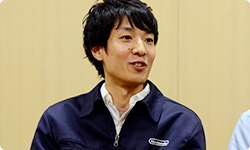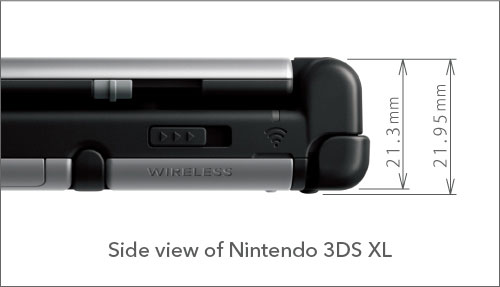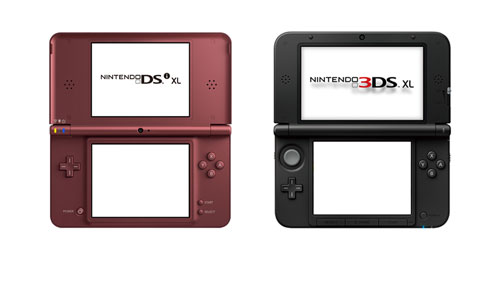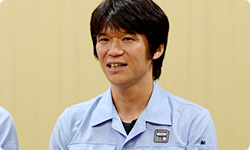3. Good but Inexpensive
Taking the conversation back a little, I’d like to ask about the design. Miyatake-san, when you first saw the working model, what did you think from the point of view of design?
I remember I was surprised, like “Wow!!” It made me think, “This’ll go well!”

Thinking, “If those of us making it are surprised, then surely the players will be!”
That’s what I thought. I really did.
The LCD is bigger on Nintendo 3DS XL, but with regard to the overall size of the system, the thickness hasn’t changed much, has it?
The website says it’s 22 millimetres thick, but that number includes the feet-like projections. Without it the thinnest part is 21.3 millimetres, only 0.1 millimetres more than Nintendo 3DS.
But that 0.1 millimetre really rankles! (laughs)

(laughs)
It’s larger, while being practically as thin – it feels more compact when you actually see it.
If you look at the size measurements, it’s close to Nintendo DSi XL, but if you compare them side-by-side, it seems pretty small. And the corners are rounded, so it feels good when you hold it and feels easy to carry around.

We designed it with the concept, “A softer Nintendo 3DS with a bigger screen.” It was only made possible because it was a larger piece of hardware, but the battery is in the centre of the main body this time, so we could achieve more rounding on the exterior surfaces than ever before. With the battery in the centre, the balance of weight is good.
We had a preview at the general meeting of shareholders the other day (June 28, 2012), and when the shareholders got their hands on Nintendo 3DS XL, they complimented it, saying, “It’s easier to carry, and the balance is better than I thought."
Oh, they did! I’m so glad to hear that! (laughs)
You also attempted a new method for adding decorations to the exterior, didn’t you?
We did, in order for people to be able to casually carry it around like they are doing with Nintendo 3DS, we thought first and foremost of a neutral design, one without much difference between the top and the back of the system. We looked at ways we could give it variation by changing the colours and patterns of the exterior. A big point design-wise in allowing it to have those variations was the method of decoration. We looked at various methods and technologies, but based on cost and marketability, we ended up adopting IMD.
Could you explain a little about what IMD is?
It’s a method of moulding using film. You take a film already printed with the colouring, insert it in the metal mould3 and press them together with resin. 3Metal mould: A container in an inverted form of the shape you want to cast. They are often made of metal. Plastic and other materials are poured into them for mass production.
If I remember correctly, you used IML for Nintendo 3DS. How are IML and IMD different?
They’re both film moulding, but in IML, the film remains as a protective layer on the surface, while in IMD, the film is removed in the end. After removal, only the colour and pattern layers and the UV printed layer remains.
Simply put, it depends on whether there’s a protective layer including the film itself or the film is removed and only the printed part remains. Is that correct?
Yes. They each have their merits and drawbacks, but the IML that we used for Nintendo 3DS had an advantage toward forming three-dimensional shapes compared to IMD.
That’s why it was used for things like the buttons. Had Nintendo ever used IMD before?
We did use it for the face plate on the Game Boy Micro4 system and for the Pokéwalker5. 4Game Boy Micro: A handheld game system that was small, light and compatible with the Game Boy Advance system. Released September 2005 in Japan. The face plate could be removed and exchanged with others sold separately. 5Pokéwalker: A pedometer that was packed in with Pokémon HeartGold and Pokémon SoulSilver for the Nintendo DS system. Released September 2009 in Japan.
As for the path toward choosing IMD this time, (Hironori) Akai-san6 - who isn’t here today - and I had a manufacturer introduce IMD technology a little before the project began. Akai-san really liked it and often pushed us to use IMD. 6Hironori Akai: Research & Engineering Department. See Iwata Asks: Nintendo 3DS

And what a push it was! (laughs)
Why did Akai-san like IMD so much?
Compared to painting, it’s easier to apply various colours with a single foil (film) sheet, so fewer defects arise, increasing yield7 and decreasing man-hours. The good cost benefit is why Akai-san pushed for it. 7Yield: Amount of good production units being made in the manufacturing process.
If you tried to paint the same thing, first you would have to take the housing8 and apply masking9 on certain parts, paint it, and then, to finish up, probably apply a UV protective layer, and repeat those stages. If dust would mix in or an application becomes uneven at one of those stages, the unit won’t be usable. The more manufacturing processes there are, it’s unavoidable for the yield to fall and ultimately have a big effect on cost. 8Housing: One of the parts that composes the casing. It covers and protects the outside of the device. 9Masking: Covering parts of an object to be painted so that certain areas will remain unpainted.
Yes, that’s right.
In the case of IMD, the colours are already there with the film printing, and the UV protective layer is already on the surface from the start, so it’s better from the perspective of cost. Is that right?
Yes, exactly! Thanks again! (laughs)
After you decided on IMD, did it go smoothly?
No, it wasn’t that easy. The film is thin, so on the back where you pour in the resin, the film would run and warp.
Ah, it warps because of the resin.
Yes. It was a specific method, so all sorts of problems arose during the testing phase. We had the manufacturer come to the factory in China and observe the problems, and for film design, thought about bending it ahead of time in expectation of distortions during mass production. We were discussing it until about two weeks before mass production began and somehow made it in time.
Usually, you shouldn’t be doing such things at that point…but you were.
Yeah. (laughs wryly)
You can’t see such difficulties from the final product. If you attempt something new, it never goes off without a hitch.
Yeah, and it didn’t.
But in the end, the IMD looks great, and the balance is great, so it wasn’t all about cost.
That’s right. In that way, and from the standpoint of design, we really wanted to give players something good but inexpensive. Also, starting with the first approval of the design, I put estimated costs up alongside the various proposals.
That’s right. It was like lists of calories you sometimes see on menus.
(laughs)
I really would like people to see it for themselves.